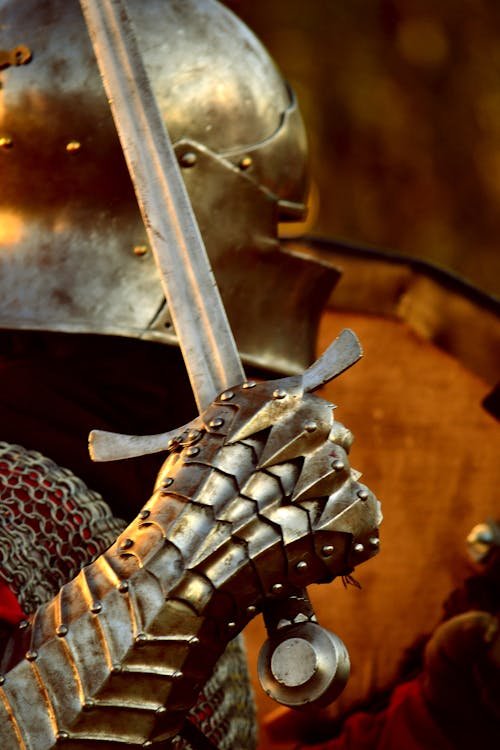Skull Conclave
Skull Templars, Calvarians, Tougu, Baskets
”Lethal is the Templar’s blade.
Deadly is their Spell.
More Vorpal is the Templar’s faith
to those of Sin and Fell”
Artwork by Nicco Salonga
Overview
Skull Templars are theocrats and ritualists, deeply ensconced in the rites and the faith of the Temple. They are all skilled and experienced in the use of magic, if not magic-users themselves. They are the smallest of the Conclaves, though their influence dwarfs their brethren. Studious and insular, they do not often leave the bastions and strongholds of their Archfaction — though powerful magic may draw them to deadly places.
Symbol
Four human skulls at the base of the Hallowed Ziggurat. Simpler iconography has a human skull with three horns inside an tapered triangle. Black, white, and gold are associated with the Calvarians.
Lore: High
Playing a Calvarian requires reading in the faith, histories, and Priory details of the Archfaction. In addition, these characters are expected to adhere to certain standards if they are to remain in good standing.
Aesthetic
Moreso than their Templar brethren, Skull Templars tend to be ornamented with bones. Most wear animal bones, but it is an uncommon practice to wear the cherished remnants of auspicious and beloved relatives. Indeed, skull iconography is a frequent sight in their works and their garments. Beneath and among these macabre ornamentation, Skull Templars tend toward darker clothing, sometimes gilded with bronze or silver. Robes, cassocks, vestments, and similar clothing is preferred, though more martial Templars may eschew these for more militant attire such as battle skirts or armored overcoats.
Outlook
All for the Goddess: The Calvarians are known for their devotion to the God-Empress and her Oracle-Avatar. While feverish, unbending piety is not universal, every Skull Templar is expected to know and live by the tenets of their faith, in appearance if not in heart. Failure to adhere to these values is punished harshly, especially in the case of heresy. That said, the Oracle-Avatar’s mercy occasionally allows them to be dismissed instead of executed, though some Bishops and Hierophants can be quick with their “justice” as well as zealous.
Life and Death: The God-Empress is a Goddess of life and of death. Killing humans is against her wishes, unless it is in self-defense or under the commands of a religious superior (who must answer to the Oracle-Avatar if this death is unnecessary). But when moved to kill a monster or a human, the Skull Templars do so with a hungry zeal. Many commemorate the deaths of their foes to the God-Empress, with the last of their pain and blood offered to the Earth Mother beneath. This can be particularly unnerving for those who see Calvarians as largely passive and prayerful rather than bloodthirsty.
Close to Divinity: The Skull Templars are considered to be the closest to the Oracle-Avatar compared to the other two Conclaves. Thus, many look to them for wisdom or jump to assist them with any issue. This is far from universal, of course. While a superior ranking Talonite or Carminian might give a nod to a lower-ranking Calvarian’s words, they are under no responsibility to utterly follow the Skull Templars’ orders or demands. Furthermore, Calvarians who consistently treat the other Conclaves as servants might find themselves chastised by their superiors or worse yet, they might attract the Priory of Judicion’s interest.
Suffer for the Goddess: At the end of his life, the Skull Archon suffered and died in the Oracle-Avatar’s name. No stranger to agony, his own Diabolic magics wracked his body with every casting. Thus, pain and suffering is not so stigmatized among the Calvarians. While the torture of an enemy might not yield information, it can be made blessing and turned into an offering to the Goddess. Some extremist Calvarians engage in self-flagellation as a contrition for their ways or as a form of prayer to the God-Empress.
Watch and Learn: The Calvarians are rarely known for their impetuousness and spontaneity. They are content to observe a situation or even retreat if there is no reason to interfere. In fact, observing and recording a situation can appear to be the most active that a Calvarian can be, on occasion. Truthfully, Skull Templars can be just as patient (or impatient) than most other individuals -- the difference is that they are conditioned toward only acting or speaking in full knowledge rather than without it.
Names
When an individual is born to the hallowed ranks of the Skull Conclave, they are given a First Name by their parents and blessed by a family name derived from their familial Sept (if any). However, when such an individual joins the clergy and a Vertebral Priory in full, then they must cast aside this first name to be mantled with their Omen Name (which is usually a long adjective). Naturally, they also assume a title befitting their station within the Conclave. You can create a random Omen and Sept name below.
Example Familial Sept names: The Familial Septs are ancient and storied families within the Conclave, with many honored saints and martyrs within their ancestries. Individual families usually have an adjective or a similar descriptor to the Sept name.
Base Sept Names: Skull, Spine, Tooth, Claw, Fang, Any Tree, any Animal, any Mineral, Sun, Moon, Star, Sky, Cloud, Any Season
Example Sept Names: Lunar Skull, Darkened Star, Burning Bear, Verdant Spine, Azure Sun
Example Omen Names: Tenebrous, Beshadowed, Illuminated, Purified, Cleansed, Blistering, Gnarled, Enlightened, Hallowed, Sanctified
Starting Titles and Rankings:
Archonate Clergy: These are Skull Templars who are ordained or are in the process of ordination. These are always Spellcasters.
Novitiate : Untested Calvarians who have yet to complete the Sacrament of Summoning.
Disciple: Calvarians who pass their Sacrament of Summoning to join the Archonate Clergy are granted this title. There are three different grades of Disciple -- Smoke, Copper, and Iron.
Apostle: These are Disciples who have continuously proven their loyalty and ability to the Clergy and the Temple. This has three ranks -- Bone, Gold, and Obsidian.
Makers/Auxilium: These are members of the Skull Conclave who are not magic users and not clergy.
Apprentice: These individuals are trainees and novices on their path to becoming Artisans of their craft. They are the equivalent of Novitiates.
Artisan: Individuals whose products and services have been tried and tested.
Example Names:
Tenebrous Ashen Skull is of a venerable bloodline, a well omenned name, and is of the Blessed rank within the clergy. Mantled and sanctified, she no longer answers to her birth name of “Anaro” and her closest associates simply call her “Ten”.
Callous Amarth is a Templar Priest of the Disciple rank and born outside the Skull Conclave. “Disciple Callous” has had to earn their title and their rank but permits their family to call them their old name of “Adam”.
Tallim Seven Sun is an Expert Auxillarium within the Conclave, a secular craftsman and subservient to the priesthood. Born without magical talent and without the desire to pursue it, Expert Tallim is no less proficient in his chosen occupations and skillsets despite his lack of station.
Example Character Ideas
The following are some character concepts that may be seen from this Conclave. If desired, Feel free to use or alter one of these for your character.
Curious Researcher: The ruins of the World that Was and the ashes of the Ember War beckon to more than a few Skull Templars. Out there is knowledge and there are secrets awaiting minds sharp enough to find them and deliver them to the Temple. Naturally, dangers and hazards lie in wait between the Templar and their quarry. However, these deter them little -- for knowledge and for the Temple, the risk means nothing. With wit, skill, and faith, these secrets will belong to the Oracle-Avatar.
Suggested Classes: Counselor, Ranger
Defender of the Faithful: Common belief holds that the Talon Conclave are the primary guardians of the Temple, but there are some in the Skull Conclave that will not take such a statement sitting down. These individuals are trained with spell and shield to defend against the depredations of the Abyssals and the ruined world around them. No mere feeble scholars are these Templars but pillars of their faith and ramparts of their people.
Suggested Classes: Arcanist, Warrior
Servant of the Oracle: There are those whose bloodlines have bound them close to the Oracle-Avatar. Sometimes these individuals get sent to perform secret tasks… or because they failed their Conclave’s exacting standards. In either case, their proximity to the Oracle-Avatar has delivered them unto distant and dangerous territories. If they do not find their demise, they may instead find powerful magics to bring back to the Temple or a proper position with which to continue their valuable, yet distant service to their faith.
Suggested Classes: Arcanist, Ranger
Power-mad Sorcerer: For some Templars, magic and forbidden knowledge let out an clarion call and they have little recourse but to answer. The lands beyond the Conclave offer freedom to use and to research that cannot be resisted. These Templars are typically individuals of great promise but of little political stature. Thus do these souls go to the fringes of the civilized world and the wilds of the Mid-Atlantic with the hope to consume that which may consume them instead.
Suggested Classes: Arcanist, Builder
Unorthodox Cleric: The line between questioning scripture and heresy is dangerously thin but some tread it well, in service to the Temple. Unfortunately, even those skilled individuals can find themselves assigned in the worst of places, where “they can do the least harm”. These pious folk are ill-regarded despite their station, even by their Priory. However, the insights they provide and the lines they are willing to cross make them invaluable to their causes -- oftentimes, the answer to a problem lies outside the domains of the initial inquiry after all.
Suggested Classes: Arcanist, Counselor
Leadership
The Skull Conclave is a theocracy under the ultimate direction of the Oracle-Avatar. In practice however, it is governed by the Skull-Archon and the Spinal Synod (which are heads of each Vertebral Priory).
The current Skull Archon is Numinous Sundered Star, a Seraph that hails from the old familial septs of the Conclave. Sundered Star has been in his position for decades, succeeding his father for the office with a unanimous vote from the Synod. It is believed that he cares little for Mid-Atla and other regions outside of Templar territory. Only the Oracle-Avatar’s own command forced him and his Conclave to assist in the Free Tribes’ struggles against the Harbinger Hosts. The fact that the Oracle-Avatar was blinded by their duel with the Harbingers has only hardened his heart against the outsiders.
While the Synod follows his lead, it does not share the Skull Archon’s feelings on the matter. Some of the Priories are immensely interested in the new lores they could learn from the other Archfactions. Others are curious as to the nature of the Harbingers -- from a purely academic perspective, of course. Due to the disappearances and deaths of too many Skull Templars during the War over Embers, travel to Mid-Atla is restricted only to those who are assigned the tasks to do so.











